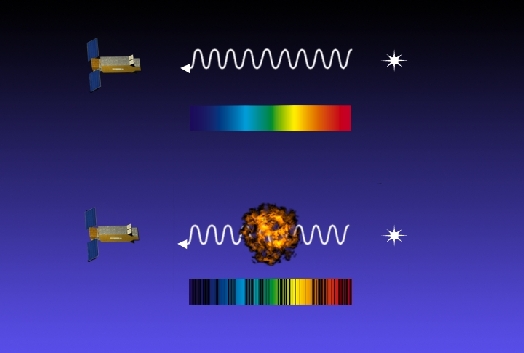

Mission Status Report #33 Star Date: May 2, 2000 This graphic shows one of the primary ways FUSE investigates the universe. When FUSE (left) observes a distant star or galaxy (right), we record the light in the form of a "spectrum" (represented by the rainbow). But if there are one or more "clouds" of interstellar or intergalactic material along the line of sight, this material imprints a sequence of dark absorption lines on the spectrum (bottom panel). It is by analyzing this celestial bar code that astronomers can learn much about the material out there between the stars. (Note that the "color bar" representation of the spectrum, which shows an optical light rainbow, is only illustrative. FUSE looks at ultraviolet light, which is not visible directly to our eyes.)
(Click graphic to see larger version.)
FUSE Continues On TrackIt's been about a month since my last report, and the news is good. The FUSE satellite is operating nominally in all regards and obtaining science data on a wide variety of science projects for both the Principal Investigator team scientists and many of the Cycle 1 Guest Investigators selected by NASA. Much of the early part of April was spent with FUSE pointing at the southern sky, where the plane of the Milky Way could be found snaking across the sky. For FUSE, this meant a rich target pool of bright objects with relatively short exposure times, which really kept the planning team hopping. There were numerous days where we observed 6-8 targets per day, more than twice our nominal average, in our most intensive observing to date with FUSE. The mirror alignments were maintained throughout this period, meaning that the data quality was also excellent through this time period. The data were coming in so fast, Warren Moos (FUSE Principal Investigator) likened it to "drinking out of a fire hose!" Many of these observations are of interest not only for the information they provide about the stars, but also because of what they tell us about the regions of gas and dust in interstellar space, out there between the stars. As the diagram at the top of the page shows, these interloping gas clouds leave a fingerprint in the spectrum of each star that can tell us much about these normally invisible regions. Since most of the gas and dust are confined to the plane of the Milky Way, the observations in April are important for the study of this material. By mid-month, we entered the period where the satellite was passing through the South Atlantic Anomaly during orbital night, which significantly cut into the available observing time. (Refer back to Status Report #28 for more info on the SAA.) We chose to use this time frame to perform an important task called an "IDS Reboot." The IDS (Instrument Data System) is the onboard computer that operates FUSE. Since December 1999, the FUSE Team has been working on a number of improvements to the code that operates this computer that will improve safety and operational efficiency, based on what we have learned about operations since launch. After thorough testing, this code was loaded up on April 18th, followed by several days of on-orbit testing while we re-established thermal controls. So far all is well. FUSE is now pointing at some fainter (but important!) objects in the northern sky, with plans to swing back to the south about mid-May. This sequence of "hemispheric" observing is currently an important part of our strategy to maintain the co-alignment of the four primary telescope mirrors on FUSE. Even as of Cycle 1 progresses, we are preparing for a new round of proposal requests from the astronomical community. NASA will soon be releasing a research announcement about this round of proposals, and we are working to prepare all of the support materials and documentation for this effort.
Reported by: Bill Blair, Chief of Mission Planning
|
